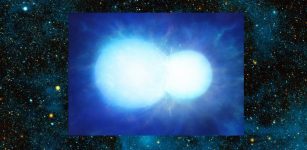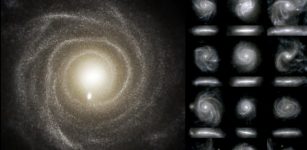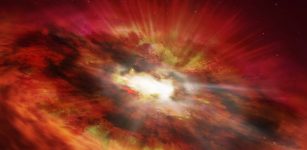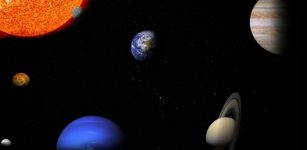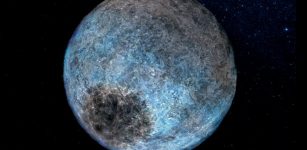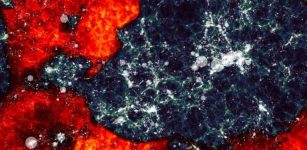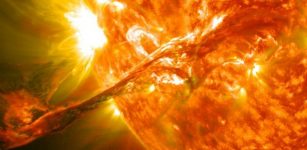Pair Of Supermassive Black Holes Discovered On A Collision Course
Eddie Gonzales Jr. – MessageToEagle.com – A distant pair of supermassive black holes (more than 800 million times that of our sun) heading for a collision, have been spotted by astronomers.
Even before the destined collision, the gravitational waves emanating from this pair will dwarf those previously detected from the mergers of much smaller black holes and neutron stars.
 A galaxy ca 2.5 billion light-years away has a pair of supermassive black holes (inset). Their locations are lit up by warm gas and bright stars that surround the objects. The finding improves estimates of when astronomers will first detect gravitational wave background generated by supermassive black holes. Credit: A.D. Goulding et al./Astrophysical Journal Letters 2019
A galaxy ca 2.5 billion light-years away has a pair of supermassive black holes (inset). Their locations are lit up by warm gas and bright stars that surround the objects. The finding improves estimates of when astronomers will first detect gravitational wave background generated by supermassive black holes. Credit: A.D. Goulding et al./Astrophysical Journal Letters 2019
“Supermassive black hole binaries produce the loudest gravitational waves in the universe,” co-discoverer Chiara Mingarelli, an associate research scientist at the Flatiron Institute’s Center for Computational Astrophysics in New York City, said in a press release.
“Gravitational waves from supermassive black hole pairs “are a million times louder than those detected by LIGO.”
The two supermassive black holes are especially interesting because they are around 2.5 billion light-years away from Earth. Since looking at distant objects in astronomy is like looking back in time, the pair belong to a universe 2.5 billion years younger than our own.
Coincidentally, that’s roughly the same amount of time the astronomers estimate the black holes will take to begin producing powerful gravitational waves. In the present-day universe, the black holes are already emitting these gravitational waves, but even at light speed the waves won’t reach us for billions of years. The duo is still useful, though.
“It’s a major embarrassment for astronomy that we don’t know if supermassive black holes merge,” says study co-author Jenny Greene, a professor of astrophysical sciences at Princeton.
“For everyone in black hole physics, observationally this is a long-standing puzzle that we need to solve.”
The gravitational waves generated by supermassive black hole pairs are outside the frequencies currently observable by experiments such as LIGO and Virgo. Instead, gravitational wave hunters rely on arrays of special stars called pulsars that act like metronomes. The rapidly spinning stars send out radio waves in a steady rhythm. If a passing gravitational wave stretches or compresses the space between Earth and the pulsar, the rhythm is slightly thrown off.
Detecting the gravitational wave background using one of these pulsar timing arrays takes patience and plenty of monitored stars. A single pulsar’s rhythm might be disrupted by only a few hundred nanoseconds over a decade. The louder the background noise, the bigger the timing disruption and the sooner the first detection will be made.
“Although supermassive black holes aren’t directly visible through an optical telescope like Hubble, they are surrounded by bright clumps of luminous stars and hot gas drawn in by the powerful gravitational tug,” Goulding says.
“For its time in history, the galaxy harboring the newfound supermassive black hole pair is the most luminous galaxy in the universe.”
“What’s more, the galaxy’s core is shooting out two unusually large plumes of gas. When they pointed Hubble at it to uncover the origins of its spectacular gas clouds, the researchers discovered that the system contained not one but two massive black holes.”
Written by Eddie Gonzales Jr. – MessageToEagle.com Staff

